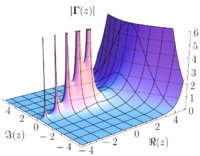
Photo from wikipedia
In this work, we obtain a third-order linear differential equation for stationary distributions of run-and-tumble particles in two dimensions in a harmonic trap. The equation represents the condition j=0, where j is… Click to show full abstract
In this work, we obtain a third-order linear differential equation for stationary distributions of run-and-tumble particles in two dimensions in a harmonic trap. The equation represents the condition j=0, where j is a flux. Since an analogous equation for passive Brownian particles is first-order, a second- and third-order term are features of active motion. In all cases, the solution has a form of a convolution of two distributions: the Gaussian distribution representing the Boltzmann distribution of passive particles, and the beta distribution representing active motion at zero temperature.
Journal Title: Physical review. E
Year Published: 2022
Link to full text (if available)
Share on Social Media: Sign Up to like & get
recommendations!